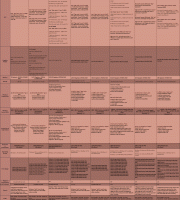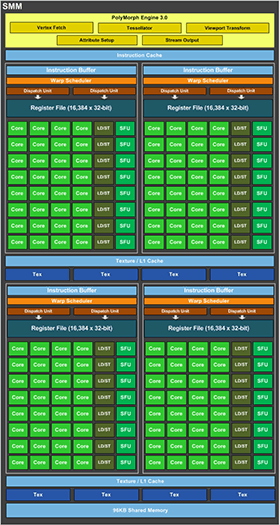


Nobody would deny a GPU’s frequency serves as a catalyst for performance, nor memory to be an influential resource. But a forum dwelling stat junkie desperate for evidence will often attribute all appreciable improvements to whichever figures have risen the most, and this time around, it was the ROPs (render output processors) that reaped their plaudits. Hoorah for the ROPs, for they hold the key to the 4K kingdom. 64 redoubtable nano-nibelungs responsible for preparing and presenting pixels to perpetually starving screen addicts.
The ratio of ROPs to Memory controllers was cited as being of critical importance, which means you are compelled to inspect the following slides . God I hate this bit.
Though it induced a larger ripple, the GM204 was not the first “Maxwell” to enter uncharted cases. A distant and diminished cousin, the GM107, endowed with eco-talents every bit as impressive, had proudly piloted the 750 Ti into the budget market almost six months earlier and the revised layout of this chip’s central components was vividly manifest in its majestic counterparts.
When sitting atop of the GTX 980, the GM204 fired on sixteen SMMs. SMXs had become SMMs, I knew what SMX stood far (streaming multi processor”extreme”) but this mysterious new “M”, sorry no idea and Google wouldn’t inform me so I proceeded unabated. These were divided into four GPCs (Graphics Processing Clusters).
 A single SMM hosted, loved and cherished a congregation of 128 streaming processors and 8 texture units. In place of the sole cathedral that housed this Cuda Core Choir when under the Kepler’s command, four discreet churches were now appointed, each with its own instructor. An alteration that Nvidia claimed coaxed the cores to sing 40% sweeter and louder than before.
A single SMM hosted, loved and cherished a congregation of 128 streaming processors and 8 texture units. In place of the sole cathedral that housed this Cuda Core Choir when under the Kepler’s command, four discreet churches were now appointed, each with its own instructor. An alteration that Nvidia claimed coaxed the cores to sing 40% sweeter and louder than before.
8 texture units served each SMM and the blue dashes above and below 2 megs of level 2 cache, those were the ROPS, 64 in total and 16 allocated to each memory controller, there where it says memory controller on the left and rights sides. And cease.
The true secrets to a “Steamer’s” smooth and speedy salvation lie in the sickeningly scientific architectural refinements that only the most accomplished hardware hagiographers could aspire to coherently convey. As one is not this article’s author, let’s survey the obvious upgrades.
Over the preceding months, several distinct, state of the art and heavily marketed gaming technologies catered for gourmets with varying tastes.
There were those that veered toward Clan 4K, whose pallets savoured their pixels in a single gargantuan portion and the others, paid up or potential members of the GSync guild, who preferred to sacrifice surgical detail for roaring refresh rates or experience a three course cocktail of colour and texture. Sooner or later, these factions would join in a triple screen, 4K, GSync wonderland with 120hz available to all.
In the mean time, Nvidia’s attempt to address what was becoming a painful dilemma for both groups of enthusiasts, came in the form of “Dynamic Super Resolution”, a process whereby all glorious graphical content is rendered at 4K and beyond, then down-sampled in accordance with the host monitor’s native resolution.
The system was enabled at driver level via Nvidia’s “Geforce Experience” software, though at the time of release, how it differed from more traditional forms of anti-aliasing, or similar options accessible from within games themselves, remained ambiguous.
Moving onto the physical changes, where before there were DVI brothers in arms, only one now remained, its doppleganger dispatched in favour of a display port. Two further display ports sat alongside, all three revision 1.2 and lastly, one HDMI socket in its second incarnation, supporting 4K at 60hz and making triple quad HD fesible on a single card.
Also worthy of mention, was the Maxwell’s extensive video harvesting and playback features. A heavily upgraded encoding engine (NVENC) meant user’s could now benefit from dedicated H.265 encoding, a function never previously observed on any PC GPU.
In addition, and of enormous significance to gaming archivists seeking premium quality, Nvidia’s maiden “Maxwell” driver package introduced profiles of 1440p and 2160p (4K) to its Shadow Play recorder, each capable of logging a “Let’s play” at 60 silky frames and 130 megabits per second!
To complement, there was MFAA Multi Frame Sampled Anti-Aliasing, yet another novel technique for touching up edges and supposedly 30% swifter than traditional MSAA, with a negligible loss in quality
Full implementation of Direct 3D 12 and an enigma referred to as “Voxel accelerated global illumination”, rounded off our Emerald Giant’s ingenious concoction. Don’t ask me to explain either in detail…because I can’t.
In 2012, a range topping video card that required no more than 195W to provide its finest service emerged, its name was the GTX 680 and the GK104 that commanded its helm was hailed as a breakthrough in the infinite paradox of performance and efficiency. Two years later, 165 watts was all that was needed for its descendant to deliver twice the delights.
Suffice to state the “Maxwell” was a solution that required less of almost every key ingredient, whilst indulging the customer with more acute flavours and a pleasant feeling of fullness. Surely a firm indication that Green Eyes and his goblins were prioritizing the development of portable, energy sparing solutions before meticulously remoulding resultant designs and components into products for those who defied a desk-less existence.